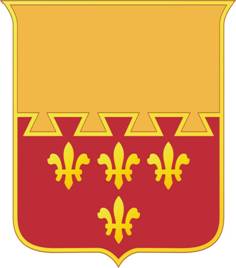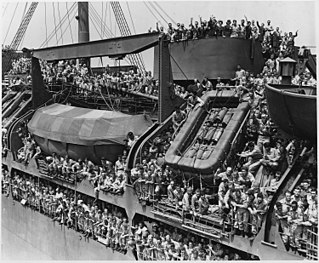
Operation Dragoon was the code name for the Allied invasion of the French Riviera. Originally planned to coincide with D-Day, it had been postponed due to insufficient landing-craft. In August, it was revived, as the zone had become a low priority for the Germans, and conditions looked favourable for the liberation of Southern France with its key ports of Marseille and Toulon.

The American Expeditionary Forces was a formation of the United States Army on the Western Front of World War I. The AEF was established on July 5, 1917, in France under the command of Gen. John J. Pershing. It fought alongside French Army, British Army, Canadian Army, and Australian Army units against the German Empire. A minority of the AEF troops also fought alongside Italian Army units in that same year against the Austro-Hungarian Army. The AEF helped the French Army on the Western Front during the Aisne Offensive in the summer of 1918, and fought its major actions in the Battle of Saint-Mihiel and the Meuse-Argonne Offensive in the latter part of 1918.

Operation Archway was the codename for one of the largest and most diverse operations carried out by the Special Air Service during the Second World War.

The Italian Campaign of World War II consisted of Allied operations in and around Italy, from 1943 to 1945. The Joint Allied Forces Headquarters (AFHQ) was operationally responsible for all Allied land forces in the Mediterranean theatre and it planned and led the invasion of Sicily in July 1943, followed in September by the invasion of the Italian mainland and the campaign in Italy until the surrender of the German Armed Forces in Italy in May 1945.

The Eastern Front of World War II was a theatre of conflict between the European Axis powers and co-belligerent Finland against the Soviet Union (U.S.S.R.), Poland and other Allies, which encompassed Central Europe, Eastern Europe, Northeast Europe (Baltics), and Southeast Europe (Balkans) from 22 June 1941 to 9 May 1945. It has been known as the Great Patriotic War in the former Soviet Union and modern Russia, while in Germany it was called the Eastern Front, or the German-Soviet War by outside parties.

Popski's Private Army, officially No. 1 Demolition Squadron, PPA, was a unit of British Special Forces set up in Cairo in October 1942 by Major Vladimir Peniakoff. Popski's Private Army was one of several raiding units formed in the Western Desert during the Second World War. The squadron also served in Italy, and was disbanded in September 1945.

The Allied advance from Paris to the Rhine, also known as the Siegfried Line Campaign, was a phase in the Western European Campaign of World War II.

Case Blue was the German Armed Forces' name for its plan for the 1942 strategic summer offensive in southern Russia between 28 June and 24 November 1942, during World War II.

The Transportation Corps was established 31 July 1942 by Executive Order 9082. The Transportation Corps is a combat service support branch of the U.S. Army, and was headquartered at Fort Eustis, Virginia, but moved to Fort Lee, Virginia in 2010. It is also one of three U.S. Army logistics branches, the others being the Quartermaster Corps and the Ordnance Corps. The Transportation Corps is responsible for the movement of personnel and material by truck, rail, air, and sea. Its motto is "Spearhead of Logistics," and it is currently the third smallest branch of the Army.

The Willys MB and the Ford GPW, both formally called the U.S. Army "Truck, 1⁄4-ton, 4×4, Command Reconnaissance", commonly known as Jeep or jeep, and sometimes referred to as G503, were highly successful off-road capable, light, military utility vehicles, built in large numbers to a standardized design, from 1941 to 1945, for the Allied forces in World War II.

The Battle for Brest was fought on the Western Front during World War II. Part of the Allied plan for the invasion of mainland Europe called for the capture of port facilities, in order to ensure the timely delivery of the enormous amount of war materiel required to supply the invading Allied forces. It was estimated that the 37 Allied divisions to be on the continent by September 1944 would need 26,000 tons of supplies each day. The main port the Allied forces hoped to seize and put into their service was Brest, in northwestern France.

The Ghost Army was a United States Army tactical deception unit during World War II officially known as the 23rd Headquarters Special Troops. The 1,100-man unit was given a unique mission within the Allied Army: to impersonate other Allied Army units to deceive the enemy. From a few months after D-Day, when they landed in France, until the end of the war, they put on a "traveling road show" utilizing inflatable tanks, sound trucks, fake radio transmissions, scripts and pretence. They staged more than 20 battlefield deceptions, often operating very close to the front lines. Their story was kept secret for more than 40 years after the war, and elements of it remain classified. The unit was the subject of a PBS documentary The Ghost Army in 2013.

Military light utility vehicle, or within military context or parlance just Light Utility Vehicle (LUV), is a term sometimes used for the lightest weight class military vehicle category. In popular terms, what is intended is a jeep-like, typically four-wheel drive vehicle for military use. They are by definition lighter than other military trucks and vehicles, inherently compact and usually unarmored, with short body overhangs for nimble all-terrain mobility, and frequently around 4 passenger capacity.

The 106th Cavalry Regiment was a mechanized cavalry unit of the United States Army in World War II recognized for its outstanding action. The group was organized in 1921 as part of the Illinois National Guard and during the Spanish–American War and World War I was known as the 1st Regiment Illinois Volunteer Cavalry. It underwent a number of reorganizations before World War II. Like other Guard units during the inter-war years, the 106th held monthly drills and yearly training. Readiness for war in 1940 led to the mechanization of the unit and induction into Federal Service at Camp Livingston, Louisiana on 25 November 1940.

The United States Army Central, formerly the Third United States Army, commonly referred to as the Third Army and as ARCENT is a military formation of the United States Army, which saw service in World War I and World War II, in the 1991 Gulf War, and in the coalition occupation of Iraq. It is best known for its campaigns in World War II under the command of General George S. Patton.

The Demobilization of United States armed forces after the Second World War began with the defeat of Germany in May 1945 and continued through 1946. The United States had more than 12 million men and women in the armed forces at the end of World War II of whom 7.6 million were stationed abroad. The American public demanded a rapid demobilization and soldiers protested the slowness of the process. Military personnel were returned to the United States in Operation Magic Carpet. By June 30, 1947, the number of active duty soldiers, sailors, Marines, and airmen in the armed forces had been reduced to 1,566,000.